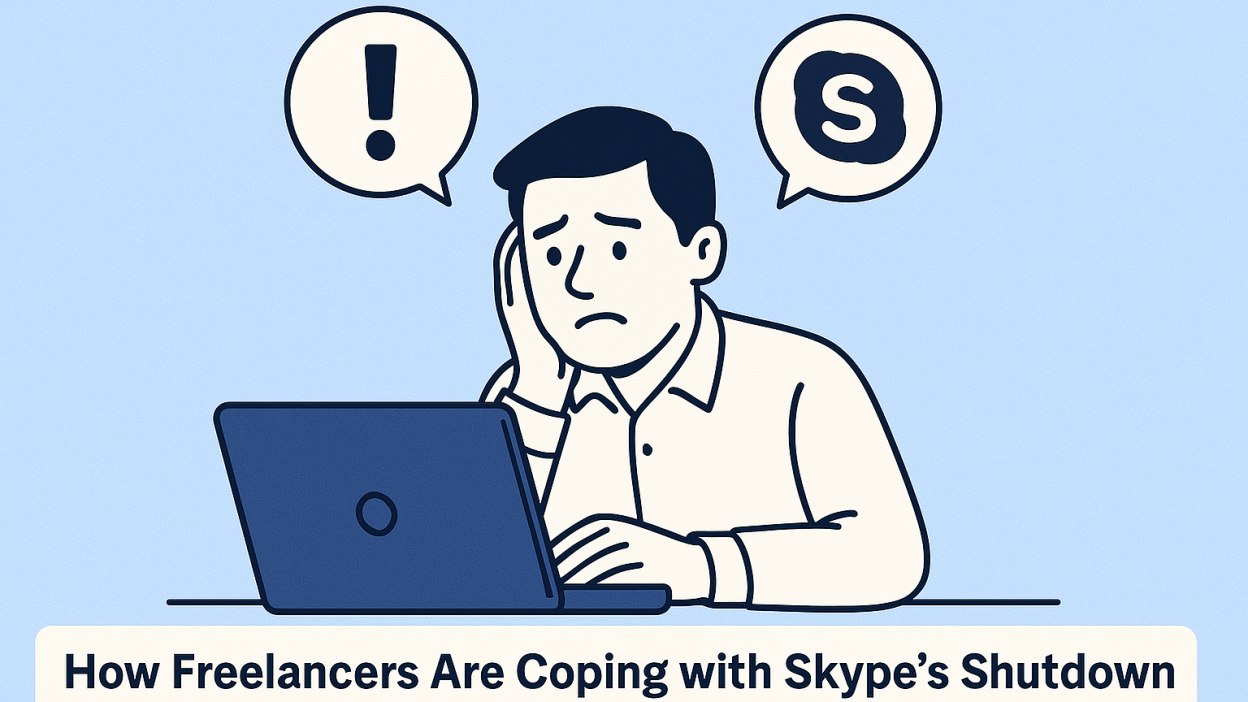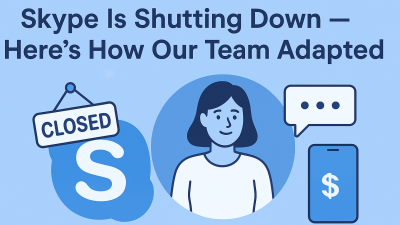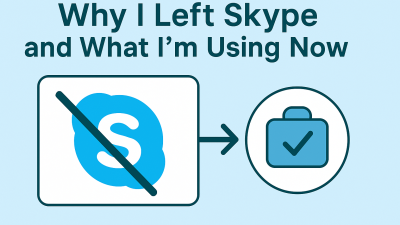When Microsoft announced Skype’s shutdown, it wasn’t just retiring software. For freelancers, it felt like someone pulled the plug on a lifeline that had been quietly keeping their work afloat.
Skype wasn’t flashy. It didn’t win design awards. But it did one thing freelancers have always needed: it connected you with clients, collaborators, agencies, and prospects, instantly, globally, reliably.
For years, it was the glue between remote professionals and the rest of the world. Then came a deadline: May 5, 2025. That’s the day Skype will be officially retired, and everything connected to it, from your contact list to your call credits- will go with it.
The response in freelance circles hasn’t been loud. It’s been quiet and a little unsettled. Because beneath the surface, the loss of Skype isn’t just inconvenient. It’s a fracture in the system that many freelancers built their entire workflows around.
Why Skype Wasn’t Just a Tool — It Was a Habit
It didn’t require onboarding. You didn’t need to create rooms, manage roles, or coordinate schedules. You just opened it, called someone, and talked.
Freelancers appreciated how Skype stayed out of the way. You could use it for a last-minute project brief, a check-in call with a client in another country, or to follow up with someone you hadn’t spoken to in six months — all from the same place.
It wasn’t part of a suite. It wasn’t trying to be a productivity dashboard. It was communication, plain and simple. The kind that fits into irregular hours and unexpected projects. The kind that adapts to your rhythm, not the other way around.
That’s what made it uniquely valuable to people working without formal teams, fixed hours, or structured roles.
Teams Isn’t Built for You — and You Can Feel It
Microsoft’s official recommendation for Skype users is Teams Free. But if you’ve tried using it as a freelancer, you already know what’s wrong.
You don’t need channels. You don’t need guest permissions. You don’t need another place to manage files, you already have backed up elsewhere. You just want to talk — clearly, reliably, and without friction.
Teams is a product designed for companies. It assumes you have a calendar full of meetings. It assumes your collaborators are inside the same system. And it assumes you want your messages to exist inside threaded, trackable structures.
As a freelancer, you don’t need another platform to manage your communication. You need one that delivers it quickly, clearly, and without twenty clicks.
This is where a lot of freelancers are getting stuck. They’re being asked to adopt a tool that doesn’t reflect the way they work.
The Quiet Scramble: Freelancers Are Rebuilding Their Stacks — Piece by Piece

Nobody’s posting dramatic threads about the death of Skype. Freelancers are just… quietly adapting.
Some are dusting off old Zoom accounts. Others are jumping into Signal or Telegram for client chat. A few are revisiting Google Meet. Discord is showing up more than anyone expected, especially in creative fields.
But what’s missing, across all these tools, is something Skype handled effortlessly: international calling.
It was Skype’s least flashy feature, and maybe its most essential. Freelancers didn’t just use it to talk. They used it to invoice, pitch, negotiate, support, and close. With clients across borders, time zones, and platforms, having a reliable way to call any number, mobile or landline, without asking someone to download another app was quite a superpower.
Now that’s gone. And most freelancers don’t realize just how much they depend on it — until it stops working.
The Gap Skype Leaves Behind Is Bigger Than Microsoft Thinks
This isn’t just about habits. It’s about the tools freelancers use to survive.
Skype wasn’t perfect. But it gave freelancers three things most modern platforms don’t:
-
Reach: you could call anyone, whether they were online or not.
-
Affordability: international calls that didn’t destroy your margins.
-
Independence: no need to sync calendars, onboard clients, or set up shared folders.
Teams doesn’t replicate this. Neither does Zoom, or Google Meet, or Slack.
And that’s where the real cost of Skype’s shutdown is starting to show. Freelancers aren’t just losing a messaging app. They’re losing a direct line to their work.
When Every Hour Is Billable, Complexity Is the Enemy
Freelancers don’t get paid to figure out new tools. They get paid to deliver. So when a communication platform forces them to adapt to it, instead of quietly supporting the work, it’s not just frustrating. It’s expensive.
This is the part most platforms overlook. When Skype shuts down, freelancers aren’t just “looking for alternatives.” They’re trying to plug a very real hole without rebuilding their process from scratch.
The goal isn’t to replace Skype with something trendier. It’s to find tools that disappear into the background while the work gets done.
Why the Freelance Mindset Is Shifting Toward Focused Tools
There’s a difference between “best in class” and “best fit.” Freelancers aren’t shopping for feature sets. They’re looking for fit tools that slide into their workflow without pulling them out of it.
And post-Skype, what’s rising isn’t the platforms with the most integrations. It’s the ones with the least resistance.
Freelancers are starting to rebuild their communication stacks with clarity. Not complexity.
They’re no longer asking:
“What’s the most powerful app?”
They’re asking:
“What’s the simplest tool that does this one thing really well?”
Because that’s how real freelance workflows are shaped — around doing, not configuring.
What Skype Did for Freelancers That Most Tools Don’t
To understand where freelancers are heading, you have to look at what they’ve lost.
Skype offered something unique: the ability to call anyone, anywhere, using a real number, without depending on whether they’d downloaded an app, joined a link, or created an account.
That meant:
-
You could reach clients in rural areas who didn’t use video tools
-
You could call a hiring manager’s landline if they didn’t pick up online
-
You could follow up with leads across countries without navigating platform lock-ins
This isn’t nostalgia — it’s a use case that never stopped being relevant.
And most new platforms ignore it entirely. They expect everyone to be on the same system. But in freelancing, that’s almost never the case.
Where MyTello Steps In — Not as a Replacement, But as a Continuation
This is where MyTello comes in — not as a flashy “Skype alternative,” but as a tool that picks up where Skype quietly did its best work: international calling, with no drama.
MyTello isn’t trying to be an all-in-one platform. It’s not building dashboards. It doesn’t need your contacts to use it. It just gives you what you lost when Skype shut down:
A clean, affordable, direct way to call mobile or landline numbers in other countries.
That simplicity is exactly why freelancers are starting to turn to it, especially those who still work across borders, languages, and time zones.
What MyTello Offers Freelancers That Actually Matters
If you’re a freelancer who’s used to navigating client calls across five time zones and three continents, here’s what MyTello gives you that other apps don’t:
-
You don’t need your client to install anything. You dial their number. They pick up. That’s it.
-
You only pay for what you use. No subscriptions, no bundles, no “plans.” Just clear per-minute rates, so you can call without anxiety.
-
You can use any phone — mobile or landline. You’re not locked into using your laptop or a specific app interface.
-
It just works. No frozen video, no call drops, no “wait for them to join.”
And maybe most importantly:
It respects your time. You don’t have to learn a new interface or manage another contact list. You just sign up and start calling.
Real Use Cases from Freelancers Switching to MyTello

These are real-world reasons freelancers are turning to MyTello:
-
A content strategist in Berlin who calls her UK client’s office line twice a week for editorial meetings, no Teams invite needed.
-
A designer in Mumbai who uses MyTello to check in with clients in the U.S. and Australia, even when they’re on mobile.
-
A remote agency PM in Nairobi who follows up with contractors across Europe without worrying about who’s using which tool.
In every case, the same pattern emerges:
Freelancers need to communicate across borders without adding friction to the process. MyTello gives them that, nothing more, and nothing less.
How to Make MyTello Part of a Simple, Focused Freelance Stack
You don’t need to overhaul your system to use MyTello. That’s the point. It’s a drop-in solution for the one thing most modern platforms fail to offer: global phone access without complexity.
A simple, effective freelance communication stack might look like this:
-
Chat: WhatsApp or Signal for client updates
-
Video: Zoom or Meet for scheduled presentations
-
Docs: Google Workspace or Notion
-
Calling: MyTello for mobile/landline outreach
That’s not bloated. It’s purposeful. And in a landscape full of overbuilt tools, purposeful is what actually lasts.
Why the Future of Freelance Tools Isn’t “All-in-One” — It’s Fit-for-Purpose
The death of Skype is a reminder that no tool lasts forever. And that’s okay, because it forces freelancers to get sharper about what they actually need.
You don’t need to switch from one all-in-one platform to another. You need to build a toolkit that reflects your workflow, your clients, and your pace.
If Teams feels too heavy, if Zoom feels too formal, if Google Voice feels too US-specific — you’re not stuck. There are tools like MyTello that do exactly what you need, no more and no less.
That’s not just a workaround. That’s how freelancers stay free.
Final Words: The End of Skype Is the Start of Something More Focused
Skype gave freelancers a direct line to the world. It’s going away. That matters.
But it also opens the door for better-fit tools to step in, tools that serve freelancers on their terms.
MyTello doesn’t try to be Skype. It doesn’t try to be everything. It gives you what Skype once did so well: affordable, easy, direct global communication, without the extras.
That kind of simplicity isn’t a downgrade. For freelancers, it’s progress.



